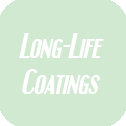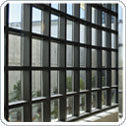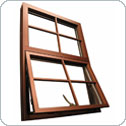About Anodizing
Anodizing
Anodizing successfully combines science with nature to create one of the world's best metal finishes.
Anodizing is the process of electrochemically controlling, accelerating and enhancing oxidation of an aluminum substrate. The anodizing process, because it is an integral part of the substrate, produces an oxide film that is uniform, hard and protects the rest of the aluminum substrate from deterioration - providing excellent wear and abrasion resistance with minimal maintenance in most environments.
The coating produced is extremely durable, and the hardness of the surface is comparable to a sapphire—the second hardest substance on earth. This characteristic makes anodize an excellent choice for use in high-traffic areas where resistance properties are important.
Anodized aluminum resists the ravages of time, temperature, corrosion, humidity and warping, adding to it's long life cycle. Anodized aluminum is an inert material that is not combustible, 100% recyclable and poses no health risks.
Electrolytic Two-Step Anodizing Process
The typical anodizing employed in the architectural industry is called two-step electrolytic.” The actual anodizing and coloring of the aluminum occur in separate steps of the process. The anodizing step takes place in a tank that contains a solution of sulfuric acid and water. The tank is charged with electrical current, and aluminum oxide is formed on the surface of the aluminum.
After anodizing is complete, the parts can be immersed in an optional coloring tank, to achieve bronze or black tones instead of the standard clear or silver finish. In the coloring tank, the anodized aluminum is immersed in a bath containing an inorganic metal such as tin, cobalt or nickel, which are deposited in the anodic pores by means of electrolytic current. The amount of time the part is immersed will determine the color achieved. Darker colors are created by extending the immersion time and increasing metal deposition. The colors typically seen on architectural products range from champagne to dark bronze and black.
Architectural Class I and Class II Anodize
Class I and Class II anodic coatings are designations created by the Aluminum Association for the purpose of codifying the specification of anodized aluminum.
Class I coating has a mil thickness of 0.7 (18 microns) or greater
Class II coating has a minimum mil thickness of 0.4 (10 microns)
Class I coating is a high performance anodic finish used primarily for exterior building products and other products that must withstand continuous outdoor exposure.
Class II coating is a commercial anodic finish recommended for interior applications or light exterior applications receiving regularly scheduled cleaning and maintenance such as storefronts.
Coating thickness can be measured by an "eddy current", a nondestructive test instrument, or by cutting a cross-section of the anodized aluminum, mounting it in a slide, polishing the edge, and reading the coating thickness directly with a microscope.
Class I and Class II coatings should not be confused with Type I, Type II, and Type III anodic coatings as described in the authoritative anodizing standard, MIL-A-8625. Type I anodize refers to chromic acid anodizing. Type II is normal "clear" sulfuric acid anodizing. Type III is "hardcoat" using sulfuric acid or mixed chemistry electrolytes.
All Linetec anodize finishes are a Class I coating, with the exception of ANO-204 Clear, which is a Class II coating. Clear anodize is available in both Class I and Class II. Class I anodize coatings are the only finishes that carry a warranty.
Linetec utilizes a more eco-friendly etching method within the anodizing process. Eco friendly anodize improves the finishes ability to hide small defects in the the aluminum and works exceptionally well with recycled billet.
Copper anodize offers the look of rich, real copper without such shortcomings as salt run-off stains, galvanic corrosion and patina. This unique and consistent process involves using actual copper to color the aluminum while isolating the copper in the coating.
Class I anodize is used on the exterior of architectural projects. It has a higher mil thickness than Class II anodize; it is more resistant to salt spray and the sea coast; and it is more durable in high traffic areas.
Class I anodize, with a minimum mill thickness of 0.7 (18 microns), can be a suitable choice for coastal climates as it possesses exceptional resistance to corrosion, discoloration and wear; however, its natural beauty can be marred by harsh chemicals, rough conditions or neglect. These conditions may only affect the surface finish and not reduce the service life of the aluminum, but mortar, cement, and other alkaline materials will quickly corrode an anodize finish if allowed to dry on the metal surface.
Class I anodize meets or exceeds all requirement of AAMA 611 “Voluntary Specification for Anodized Architectural Aluminum
The performance strengths and limitations of paint are summarized as follows:
Strengths of Anodize
Limitations of Anodize
Anodize Overview
Anodize Questions
Linetec's Anodize
 Architectural Class I Anodize
Architectural Class I Anodize
Strengths & Limitations
Brochures | 3-Part CSI specifications | CAD details
Source: https://linetec.com
05 05 13 - Shop-Applied Coatings for Metal
09 96 00 - High-Performance Coatings
09 97 00 - Special Coatings
09 97 13.13 - Interior Steel Coatings
09 97 13.23 - Exterior Steel Coatings


 Eco-Friendly Anodize
Eco-Friendly Anodize Copper Anodize
Copper Anodize